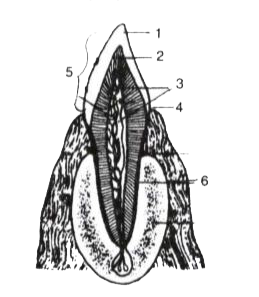Describe parts of frult with diagram .
The fruit is a mature or ripened ovary , developed after fertilisation . If a fruit is formed without fertilisation of the ovary. It is called a parthenocarpic fruit. Generally, the fruit consists of a wall or pericarp and seed. Seed is enclosed by pericarp in a fruit.
Pericarp may be dry or fleshy . When pericarp is thick and fleshy , it is differentiated into the outer epicarp, the middle mesocarp and the inner endocarp.
More Infortnition :
Types of fruits : On the basis of origin and development there are three types of fruits : (a) Simple Fruit (b) Aggregate Fruit (c) Composite Fruit.
(a) Simple Fruit : The fruit which develops monocarpellary ovary or polycarpellary ovary . Such fruits are dry or fleshy. (i) Pericarp of simple dry fruit are dry . It has two types
(1) Dehiscent and (2) Indehiscent
When pericarp of dry dehiscent fruit becomes mature, it releases seed by exploding in various types.
On the basis of explosion Dehiscence it can be classified in various types. Like (1) Follicle (2) Legumes and Capsule and Siliqua
Simple indehiscent dry fruit : No explosion of wall of mature fruit occurs. Pericarp naturally degenerates and releases seed.
Their development occurs from monocarpellary or fused polycarpellary which is one chambered or one ovuled e.g. caryopsis, achene, cypsela, nut and samara are types of Indehiscent fruits.
Fleshy Fruit : In fleshy fruits pericarp is fleshy. There are three types of it. (i) Drupe, (ii) Berry and (iii) Sebia
Drupe : In mango and coconut, the fruit is known as a drupe. They develop from monocarpellary superior ovaries and are one seeded.
In mango the pericarp is well differentiated into an outer thin epicarp, middle fleshy edible mesocarp and an inner stony hard endocarp.
In coconut which is also a dipe, the mesocarp is fibrous.
Topper's Solved these Questions
- MORPHOLOGY OF FLOWERING PLANTSBOOK - KUMAR PRAKASHANCHAPTER - MORPHOLOGY OF FLOWERING PLANTSEXERCISE - Section-B (Diiference /Scientific Reasons)
4 Videos
- MORPHOLOGY OF FLOWERING PLANTSBOOK - KUMAR PRAKASHANCHAPTER - MORPHOLOGY OF FLOWERING PLANTSEXERCISE - Section-B (Give scientific reasons)
3 Videos
- MINERAL NUTRITIONBOOK - KUMAR PRAKASHANCHAPTER - MINERAL NUTRITIONEXERCISE - QUESTIONS FOR MODULE (IMPORTANT MCQ FOR NEET)
4 Videos
- NEURAL CONTROL AND COORDINATIONBOOK - KUMAR PRAKASHANCHAPTER - NEURAL CONTROL AND COORDINATIONEXERCISE - OBJECTIVE SECTION (FILL IN THE BLANKS)
12 Videos
Similar Questions
Describe the parts of a fruit. Draw a well labelled diagram showing the different parts of a fruit.
View SolutionDescribe the structures that constitute the mouth parts of a cockroach with diagram.
View SolutionDescribe a fuel cell with a neat diagram.
View SolutionDescribe the structure of a stoma with a diagram.
View SolutionDescribe the different parts of a neuron with a suitable diagram.
View SolutionWith a neat, labelled diagram, describe the parts of a typical angiosperm ovule.
View SolutionWith a neat, labelled diagram, describe the parts of a typical angiosperm ovule.
View SolutionWith a neat, labelled diagram, describe the parts of a mature angiosperm embryo sac. Mention the role of synergids.
View SolutionWith a neat, labelled diagram, describe the parts of a mature angiosperm embryo sac. Mention the role of synergids.
View SolutionStudy the diagram given below and then answer the questions that follow :

Describe the structure of the part labelled '3'.
View Solution
